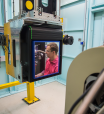
Statement of Expectations
On the 9th of December 2022, the Minister for Industry, Science and Technology provided his Statement of Expectations to ANSTO.

Showing 81 - 100 of 234 results

On the 9th of December 2022, the Minister for Industry, Science and Technology provided his Statement of Expectations to ANSTO.
Technical information on the Far Infrared beamline at the Australian Synchrotron.

Applications, Recent results, Publications.

Choose from our list of research topics and let your students lead a 30 minute Q&A session with our ANSTO experts.





ANSTO’s nuclear medicine processing and distribution facility assembles, loads, tests and distributes a range of nuclear medicine products, including Mo-99. The Mo-99 is dispensed into an ANSTO radiopharmaceutical Gentech® Generator where it decays to Tc-99m.
Rochelle is a skilled professional with a Bachelor of Medical Science and is an accredited health physics surveyor.

The Biological Small Angle X-ray Scattering beamline will be optimised for measuring small angle scattering of surfactants, nanoparticles, polymers, lipids, proteins and other biological macromolecules in solution. BioSAXS combines combine a state-of-the-art high-flux small angle scattering beamline with specialised in-line protein purification and preparation techniques for high-throughput protein analysis.

ANSTO has over 35 years' experience in providing radiation safety management with teams offering radiation consultancy, instrument calibration and radiation safety training tailored to our clients' needs.
A new imaging technology developed at ANSTO makes it possible to image, identify and locate gamma-ray radiation in a safe and timely manner.

Beamtime guide for Scientists applying to use the XAS beamline at the Australian Synchrotron.
ANSTO has collaborated on a study assessing the impact of the commonly-used food additive titanium dioxide (TiO2) on gut microbiota and inflammation.

The High Performance Macromolecular Crystallography beamline will enable the study of very small (sub-5 micrometre) or weakly diffracting crystals, providing a state-of-the-art high-throughput facility for researchers. MX3 will be able to study the structures of large proteins and protein complexes for virology, drug design and industrial applications via goniometer mounted crystals, in-tray screening, or via serial crystallography methods.
Innovative medical device Rhenium-SCT® therapy for non-melanoma skin cancer is now available in Australia